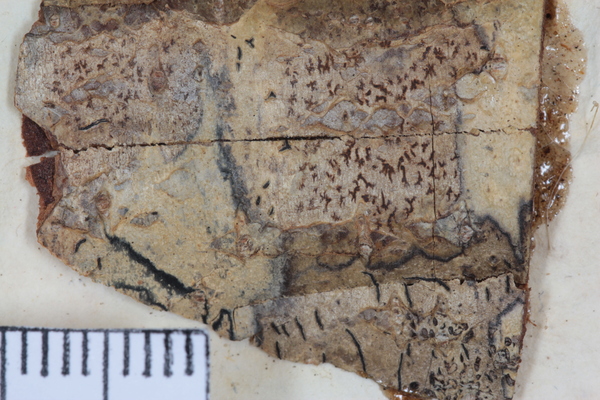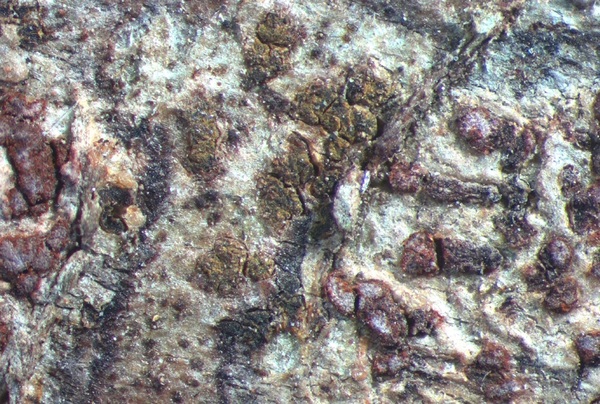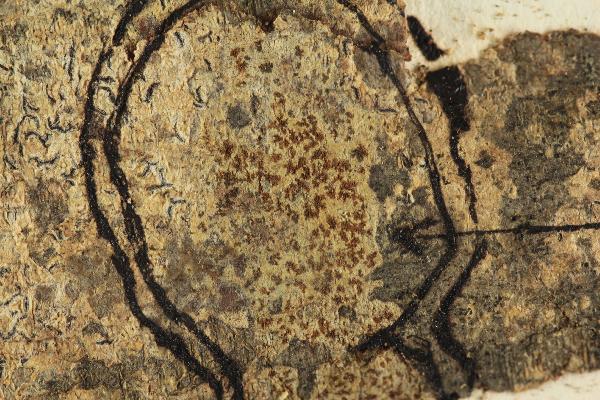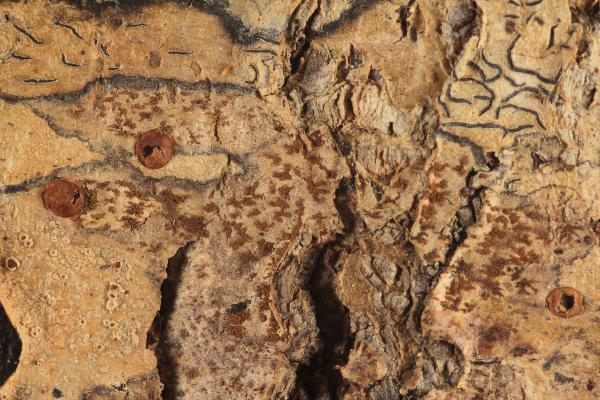Synarthonia ochracea (Dufour) Van den Broeck & Ertz
in Van den Broeck & al., Pl. Ecol. Evol., 151, 3: 343, 2018.. Basionym: Arthonia ochracea Dufour - J. Phys. Chim. Hist. nat. Arts, 87: 205, 1818.
Synonyms: Arthonia cinnabarina var. ochracea (Dufour) Nyl.; Conangium ochraceum (Dufour) Fr.; Coniocarpon ochraceum (Dufour) Fr.; Opegrapha ochracea (Dufour) Hepp
Description: Thallus at first inapparent and non-lichenized, developing on the thalli of Graphis scripta, later becoming lichenized and autonomous, up to 18 μm thick, whitish to pale brown, smooth to cracked, without a distinct prothallus. Apothecia lirelliform, often stellate to lobed, at first immersed, then semi-sessile, solitary (and then 0.1-0.5 x c. 0.1 mm), or in clusters of 2-4, 0.6-0.8 x 0.3-0.5 mm, with a blackish, but heavily ochraceous orange (cinnamon) pruinose, flat disc, without a distinct proper margin. Proper exciple 10-25 μm wide laterally, brownish; epithecium orange-brown, 20-25 μm high; hymenium brownish to reddish 40-60 μm high, I+ deep blue, K/I+ deep blue with purplish patches; paraphysoids 1.5-2.2 μm thick, the apical cells colourless, hardly swollen, immersed in gel; hypothecium orange-brown, c. 30 μm. All apothecial parts (in section) more or less inspersed with clusters of granular, orange-brown crystals reacting K+ purplish to reddish. Asci ellipsoid to obovoid, semi-fissitunicate, with a K/I+ blue ring-structure in tholus and an ocular chamber visible in young asci. Ascospores (2-)3(-4)-septate, slightly constricted at septa and with an enlarged apical cell, hyaline but turning brown and ornamented when overmature, oblong-ovoid, 11.5-17 x 4-7.5 μm, with a c. 0.7 μm thick gelatinous perispore. Pycnidia immersed to erumpent, pale, the wall composed of brown-walled hyphae. Conidia simple, hyaline, bacilliform, 4.2-5.3 x 0.8-1.3 μm. Photobiont probably absent in young lichenicolous thalli, then trentepohlioid. Spot tests: thallus K+ yellowish, C-, KC-, PD-, UV+ pale orange; apothecia K+ purplish, UV+ dark orange. Chemistry: apothecia with crystals of anthraquinones, mainly parietin.
Growth form: Crustose
Substrata: bark
Photobiont: Trentepohlia
Reproductive strategy: mainly sexual
paras Graphis scripta when young
Commonnes-rarity: (info)
Alpine belt: absent
Subalpine belt: absent
Montane belt: extremely rare
Dry submediterranean belt: extremely rare
Humid submediterranean belt: extremely rare
Padanian area: absent
pH of the substrata:
1 2 3 4 5
Solar irradiation:
1 2 3 4 5
Aridity:
1 2 3 4 5
Eutrophication:
1 2 3 4 5
Poleotolerance:
0 1 2 3
Altitudinal distribution:
1 2 3 4 5 6
Rarity
absent
extremely rare
very rare
rare
rather rare
rather common
common
very common
extremely common
Loading data...
Occurrence data
Predictive map

Source: http://dryades.units.it/lichenothecaveneta/images/species/0134_3.JPG
Trevisan, Lichenotheca Veneta 134
Growth form: Crustose
Substrata: bark
Photobiont: Trentepohlia
Reproductive strategy: mainly sexual
paras Graphis scripta when young
Commonnes-rarity: (info)
Alpine belt: absent
Subalpine belt: absent
Montane belt: extremely rare
Dry submediterranean belt: extremely rare
Humid submediterranean belt: extremely rare
Padanian area: absent
pH of the substrata:
| 1 | 2 | 3 | 4 | 5 |
Solar irradiation:
| 1 | 2 | 3 | 4 | 5 |
Aridity:
| 1 | 2 | 3 | 4 | 5 |
Eutrophication:
| 1 | 2 | 3 | 4 | 5 |
Poleotolerance:
| 0 | 1 | 2 | 3 |
Altitudinal distribution:
| 1 | 2 | 3 | 4 | 5 | 6 |
Rarity
absent
extremely rare
very rare
rare
rather rare
rather common
common
very common
extremely common
Loading data...
Occurrence data
Predictive map










